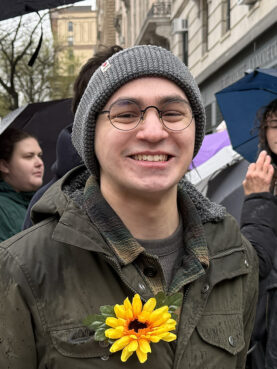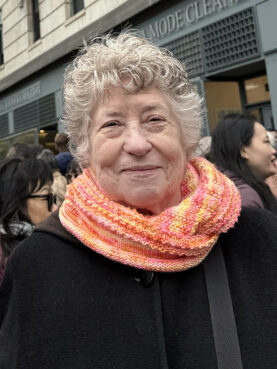
NEW YORK (RNS) — Dozens of Buddhist monastics and lay believers huddled together on a busy Upper West Side street corner on a cold, rainy day to bear witness to a historic new street sign placed in their spiritual leader’s honor Friday (April 11).
Thích Nhất Hạnh Way, located at the corner of Broadway and West 109th streets, was symbolically named in honor of the influential Vietnamese Buddhist monk, who died at age 95 in 2022.
“New Yorkers are not necessarily known for peace,” said New York City Councilmember Shaun Abreu to the crowd of robed monks and jacketed city dwellers. “We live with a lot of noise, a lot of stress. But Thích Nhất Hạnh had a message for people like us. He knew that we can’t build a better world if we’re angry all the time, or if we lose sight of each other’s humanity. By putting his name right here, we’re creating a moment of pause and of breath.”
The Zen master, considered the father of mindfulness, lived on the same block in the early 1960s, when he was studying comparative religion and teaching Buddhism at nearby Union Theological Seminary and Columbia University.
Hạnh was exiled from his home country for his opposition to the Vietnam War and his refusal to take a side. In 1967, after meeting with the peace activist, Martin Luther King Jr. nominated Hạnh for a Nobel Peace Prize. Hạnh also published books, meditations and poems targeted toward people of all ages and backgrounds.
The street naming, followers said, is one way to honor the impact of Hạnh, whom they refer to as Thay, on both Eastern and Western mindfulness communities.
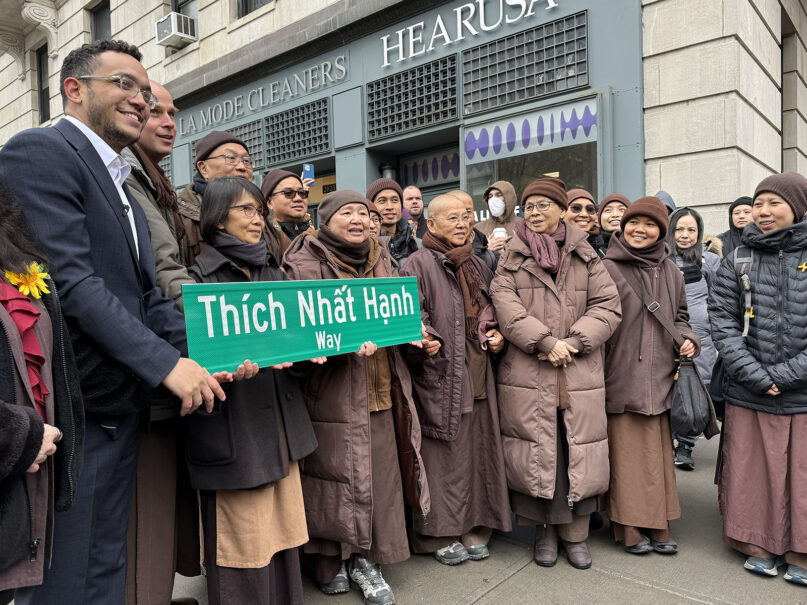
New York City Council member Shaun Abreu, left, poses with monks and nuns from the Plum Village tradition, from Deer Park and Blue Cliff monasteries, during an unveiling ceremony of Thích Nhất Hạnh Way in New York City, Friday, April 11, 2025. (RNS photo/Richa Karmarkar)
The crowd, many of whom are part of Hạnh’s Plum Village tradition of Buddhism, created a serene silence at the event — contrasting normal morning car alarms and police sirens — by using the American Sign Language version of clapping, what they called “showing their flowers.” Monastics from several of Hạnh’s monasteries, including California’s Deer Park and upstate New York’s Blue Cliff monasteries, traveled to celebrate the street naming, singing his poems after taking several deep breaths as one.
Following in the footsteps of Hạnh, the group also engaged in a walking meditation from 109th Street to the Buddhist seminary on 121st Street.
“Thay’s teaching encourages (us) to return to our breath, to find tranquility amid chaos and to cultivate compassion in our heart,” said Brother Pháp Không, a monk from Blue Cliff. “This practice of walking meditation, where each step is taken mindfully and each breath is the same, reminds us that peace is not a distant goal. He’s shown us that peace begins within ourselves.”
Brother Phap Luu, the eldest non-Vietnamese American monk in the Plum Village Buddhist tradition, was ordained as a novice by Hạnh in 2003. Luu said he considers himself among the lucky generation, traveling as a young aspirant with Hanh all over the world.
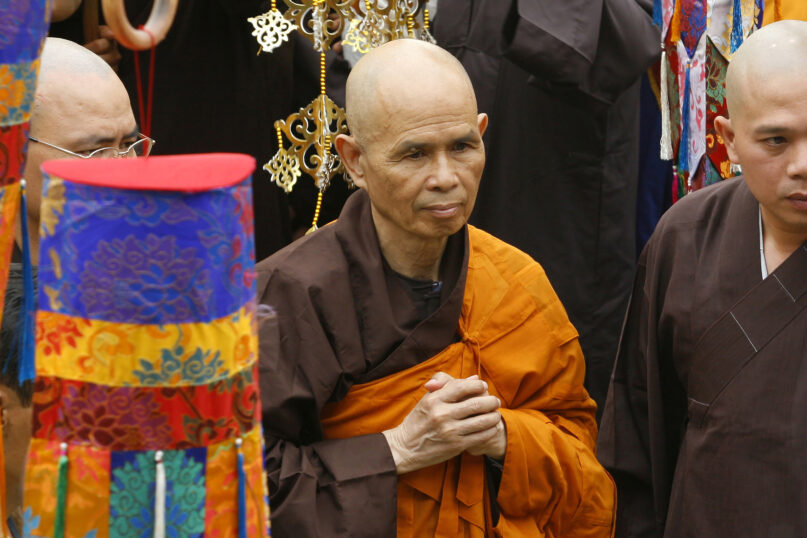
FILE – Vietnamese Zen master Thích Nhất Hạnh , center, in Ho Chi Minh City, Vietnam on March 16, 2007. (AP Photo, File)
“You can almost say we were reborn from the teacher’s mouth,” he told RNS.
Luu, who first came across Plum Village as an English student at Dartmouth College in the late 1990s, recalled how it felt when he saw Hạnh for the first time in 2002.
“We were outside in an outdoor amphitheater, and suddenly, Thay just manifested in the middle of a crowd of monks and nuns,” Luu said. “I didn’t see where he came from. It seemed like he just appeared.
“That vision of Thay amidst the monastic sangha, that is the essence of Thay. You cannot see him as an individual, as this separate person, but rather as the body of collective mindfulness practice that he has generated out of the Buddhist community in Vietnam, and then being exiled and recreating that community here in the West,” he said.
Luu spent time with Hạnh and other students at the Deer Park Monastery in the years leading up to the leader’s death. In keeping with the traditions of the Buddha, Luu said, Hạnh did not designate a successor. He instead “trained us how to use loving speech and deep listening to understand each other when there’s misunderstandings, to open our hearts to always be willing to reconcile, rather than hold resentment in our hearts.”
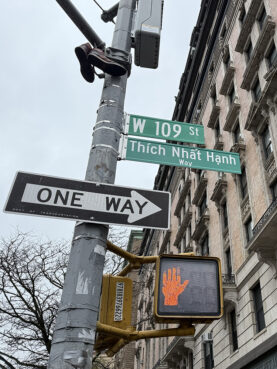
The newly placed Thích Nhất Hạnh Way street sign in New York City, Friday, April 11, 2025. (RNS photo/Richa Karmarkar)
This teaching, other followers said, is especially relevant in moments of social reckoning and intense political discord, such as the Vietnam War or ongoing movements regarding the war in Gaza.
Jonathan Gold, a 24-year-old master’s student at the nearby Manhattan School of Music, said he became “hardcore” about Hạnh’s teachings over the past year. Raised Jewish, he learned about Zen Buddhist teachings from studying sacred music and reading Hạnh’s books. Gold said through them, he found “a gateway into living more of a life of social change.”
“I think the heart of everything is through every day, every conversation, every action you take, having it be rooted in radical non-violence, radical non-harm,” Gold said. “Any time we’re having discussions with people or talking to our parents — that’s a big one — changing the language we use so that we’re approaching things with compassion and understanding rather than aggression or antagonizing. Even the people that we think hate us, or even feel like we hate, when we can transform that? Then every issue becomes, ‘How do we approach this as peacefully and compassionately as possible?'”
And while young people may be turning away from institutional religion generally, for 15-year-old Fiona Falco, Buddhist teachings help with the daily stresses of being an American teenager, from volleyball games to big exams.
“It’s just calming, and it’s fun to do it with my mom,” said Falco, who is the daughter of Elaina Cardo, a teacher in the Green Island Sangha of Plum Village in Long Island, New York.
“It’s the simplicity of the teachings,” said Cardo, who also works with Plum Village’s Wake Up Schools program, an initiative to bring mindfulness practices into grade schools through educators. “It’s not a certain time that you have to practice it, it’s in everything you do — whether it’s eating or walking.”
Joan Arenstein, 76, found Hạnh’s meditation teachings during the beginning of the COVID-19 pandemic. Arenstein said his teachings are compatible with her Jewish faith — especially “the spirituality, the ritual, the consistency and the love of all humankind.”
Arenstein, a longtime Upper West Side resident, said she looks forward to seeing the Thích Nhất Hạnh Way sign when she goes on walks in her neighborhood. A teaching she holds closest to her heart, she said, is: “Without the mud, there is no lotus. There is suffering, but there’s beauty, and we all need to stick together, (to) take care of each other.”
This story has been updated to correct Joan Arenstein’s name.

